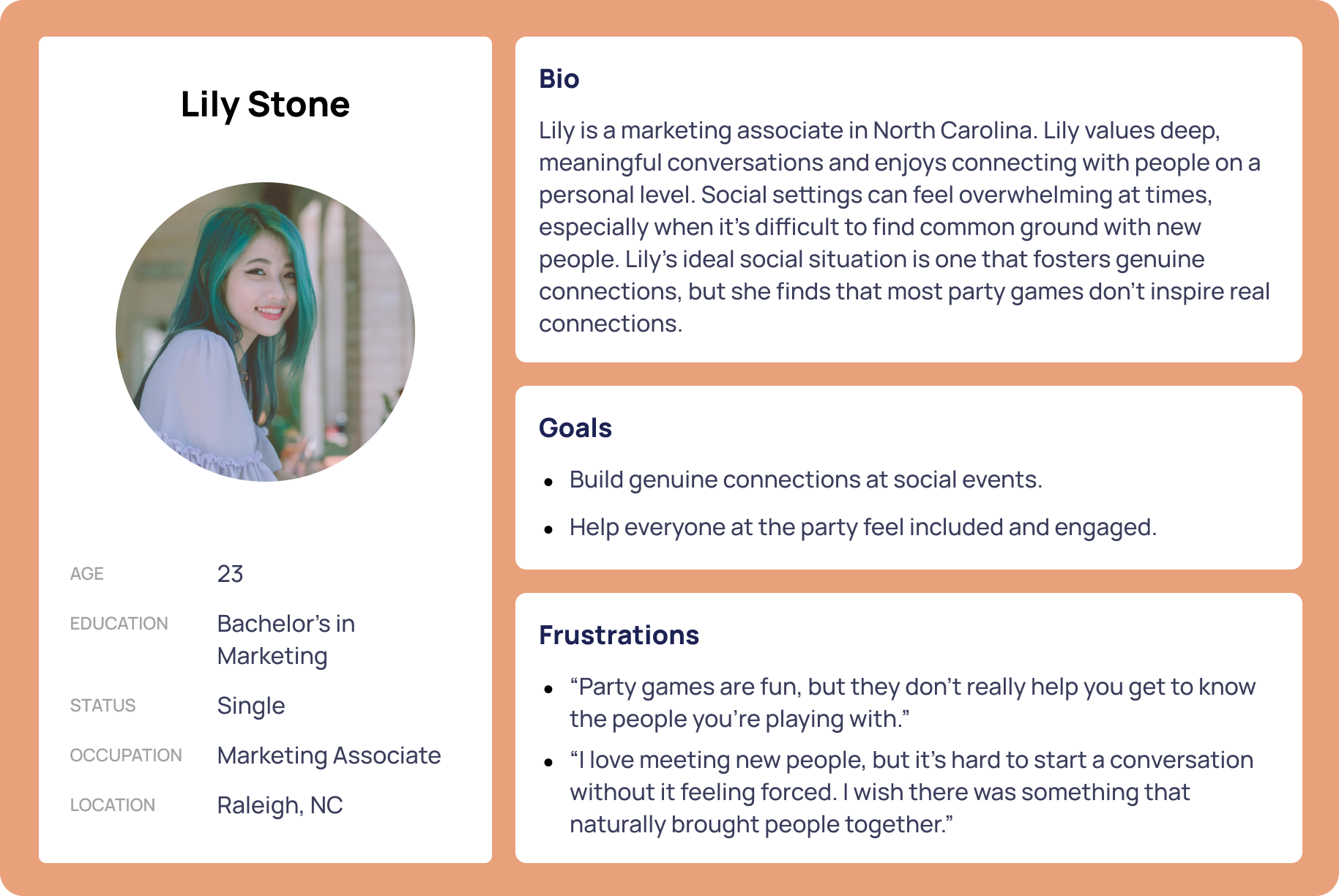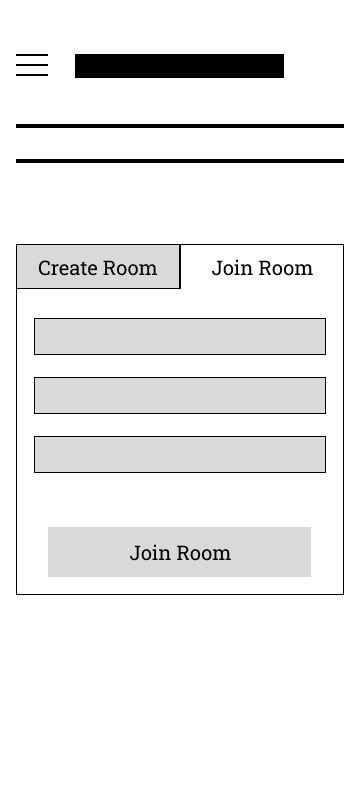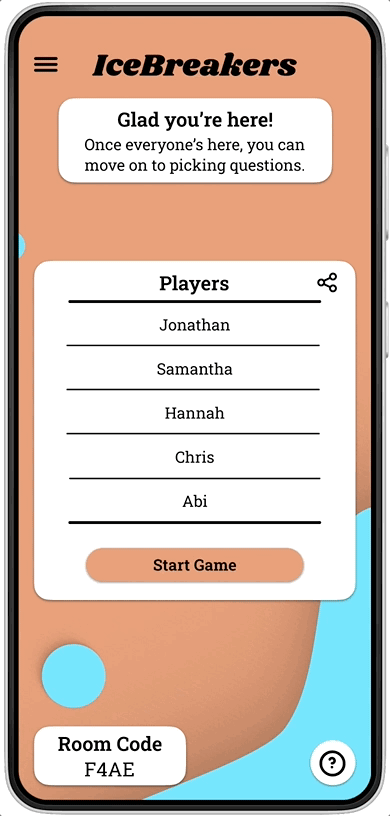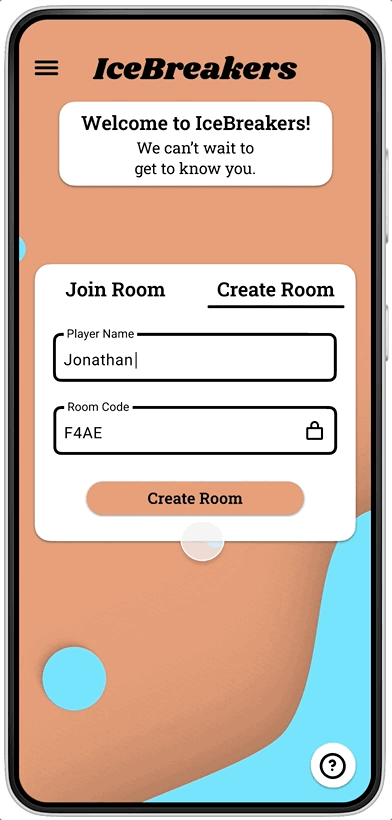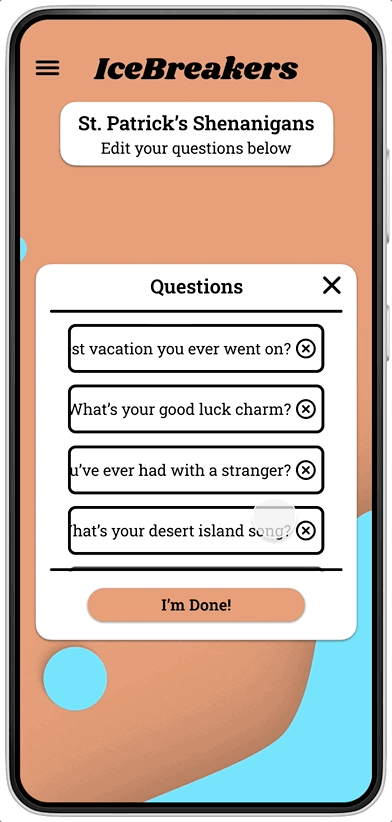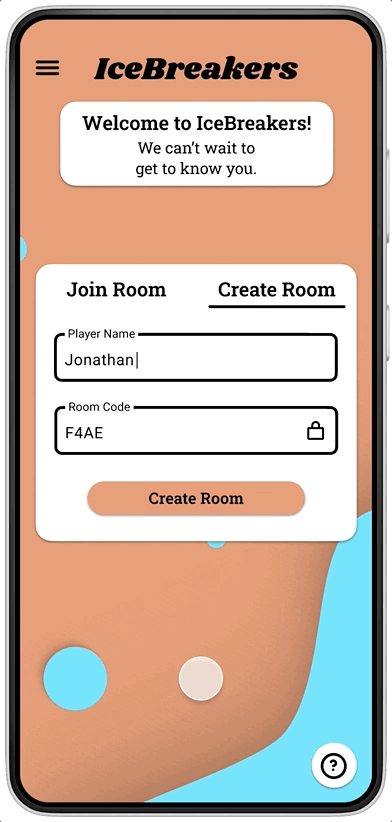IceBreakers is a social mobile party game launching in 2025. IceBreakers is designed to help people connect and get to know each other better in a fun and interactive way.
My Role
UX Researcher, UI/UX Designer, UX Strategist
Tools
Figma, FigJam, Maze, Zoom
Time
~3 months
Where it Started
IceBreakers is a social mobile party game created to transform gatherings into engaging and memorable experiences. As the Design Lead, my role was to design a fun, intuitive app that encouraged meaningful connections through interactive group experiences. IceBreakers is an ongoing project that began in late 2023, during which I collaborated with a small team using tools like Figma, FigJam, Maze, and Zoom. IceBreakers was built with the goal of creating an accessible, customizable game for all kinds of social settings.
The Problem
Social gatherings often lack engaging activities that help people connect, and they can be be awkward, especially when participants don’t know each other well. Existing party games like Jackbox are entertaining but don’t always focus on fostering direct personal connections and require setup and installation.
The Goal
IceBreakers aims to create a party game that seamlessly breaks the ice, encourages meaningful interactions, and engages diverse groups while being easy to set up and play.
Constraints & Requirements
Must be designed as a mobile, browser-based site.
Design needs to focus on the main user flow, setting up and playing a game.
User Research
I conducted user surveys in order to better understand the users I was designing for and what their needs were. The primary user group I identified were adults aged 18-35 who attend social gatherings regularly, ranging from daily to monthly.
Through user surveys and interviews, I discovered that many people find it hard to connect with others in a social setting. On top of that, many people also felt that party games were fun, but that they don’t inspire meaningful connections and that they can be complicated to setup and explain.
“Party games are fun, but they don’t really help you get to know the people you’re playing with.”
“Games that take forever to explain or set up are frustrating—it kills the vibe before it even starts.”
These interviews revealed two key pain points that we needed to focus on addressing during our creation of IceBreakers.
Pain Point #1
Social gatherings often lack tools to help people start meaningful conversations, leading to awkward silences and missed opportunities for connection.
Pain Point #2
Many games require explanations, additional equipment, or complicated onboarding, which disrupts the flow of the event and frustrates people.
These pain points were representative of two different user groups, those who find it difficult to form meaningful connections in social settings and those who are frustrated by complicated game setups that disrupt social events. I created personas to represent each of them.
Our assumptions about people finding it hard to connect with others in social settings and being frustrated by complicated setup and lack of availability of games that inspire social connection were confirmed and our goal to create a party game that encourages social connection with little to no setup was reinforced.
With a thorough understanding of user goals and frustrations, I was able to begin designing IceBreakers.
Wireframes & Prototypes
The design process began with low-fidelity wireframes to map out user flows, focusing on simplicity, easy setup, and intuitive navigation. Early sketches emphasized the onboarding process and key gameplay interactions.
I then created a high fidelity prototype for the entire user flow. Most elements stayed the same when moving from low fidelity to high fidelity, but some additional features were added.
The homepage was kept as simple and intuitive as possible, featuring a prominently placed create/join room option. This streamlined approach minimizes effort for both hosts and players, allowing them to initiate or join a game with ease. By focusing on simplicity, we ensure that IceBreakers delivers a seamless experience, reducing setup time so users can quickly dive into the fun.
If you join as a host, the room code is automatically generated and unchangeable.
After the host creates the lobby, they are able to select question packs, sorted by intimacy level. They can select a single question pack or multiple packs to be used together.
To make it easy for players to join the game, both host and player can copy a link to send others that will take them to the ‘join game’ page with the appropriate room code automatically filled. This can be accessed through the link icon or through the hamburger menu.
The room code is also prominently displayed in the lower left for people to share with each other verbally.
Once all players have joined, the host can start the game. In case the player doesn’t feel like answering or if it’s time for someone else’s turn, both the host and the player being asked the question have the option to skip to the next question.
After all of the questions have been answered, they are reshuffled, and the game continues.
Since IceBreakers is designed for mobile, a landing page was created for people who first come to IceBreakers on a desktop, letting them know to grab their phone.
Usability Study
After prototyping the core user flow of IceBreakers, I launched into testing to understand how first-time players navigated the experience and interacted with key game flows.
Testing Methodology:
10 participants, unmoderated remote usability study.
Focused on evaluating the core gameplay experience: onboarding into a room, exploring question packs, and starting a game.
Research goals included identifying usability issues, evaluating overall comprehension, and testing the effectiveness of IceBreakers’ tone and flow.
KPIs observed: task completion rates, time on task, click path clarity, and user sentiment.
Key Findings:
Onboarding felt fast and intuitive. 90% of users successfully created or joined a room within two minutes.
The game’s purpose was immediately clear. Participants quickly understood the concept — describing it as “simple, fun,” and as “good for getting people actually talking.”
Strong desires for custom question packs emerged. 75% of participants wanted create their own questions to better reflect their group’s personality, inside jokes, or specific occasions and to increase replayability.
“I’d love to make a version that’s just for my friends, with weird questions only we would get.”
It was energizing to see such clear alignment in the feedback. Players weren’t confused, they were asking for deeper control. This insight directly informed the decision to prioritize custom question packs as my next design step.
Designing for Personalization: Custom Question Packs
The Challenge
Usability testing revealed a major opportunity: users loved the game’s tone and pacing, but many wanted to personalize the content to better fit their group dynamics. Participants asked for the ability to write their own questions, whether to include inside jokes, adapt to a themed gathering, or make the game more relevant to their friends.
The core challenge was designing a flexible, editable feature that added meaningful customization without disrupting the quick, low-friction experience users already enjoyed.
The Solution
I designed a new user flow that allows players to create, name, and manage their own custom question packs.
Users can quickly start a new pack and add questions in a few clicks. Custom packs that are already created appear alongside official decks in the room setup, so they fit naturally into the existing game flow.
Questions can be edited or removed on the fly, keeping the experience fluid.
Users can create and save custom packs in advance, so they’re ready to launch when the party starts, no last-minute setup needed.
This feature was intentionally scoped to feel native to the existing design language, while unlocking a new layer of creativity and ownership for users.
The Outcome
The Custom Question Pack feature unlocked new ways for users to personalize their experience, boosting both emotional engagement and ease of use.
Increased replayability: Players can now tailor question packs to different groups, events, or moods, making each game feel fresh and unique.
Better pre-game experience: Custom packs can be set up ahead of time, reducing stress for hosts and helping the game start smoothly when everyone’s ready to play.
Stronger emotional engagement: Personalized content, like inside jokes or themed questions, deepens connection and makes the experience more memorable.
Foundation for future growth: This feature lays the groundwork for community-driven content, themed templates, and seasonal expansions.
Next, I plan to validate this flow with live users, measuring pack creation time, frequency of reuse, and whether pre-saved packs improve overall session setup and retention.
Measures of Success & Next Steps
Key Performance Indicators
In order to assess whether IceBreakers is meeting its goal of providing users with an enjoyable party game that fosters opportunities for meaningful connection while being painless to setup and start playing, we plan to track the following metrics:
User Retention: Percentage of users returning to play within 7 and 30 days
Session Duration: Average time spent per game session
Onboarding Completion Rate: Percentage of users successfully creating or joining a room
Custom Pack Adoption Rate: Percentage of players using the custom question pack feature
Testing Plans
With the core designs complete and development underway, the next phase will focus on validating new features and refining the experience through:
Usability testing of the custom question pack feature to ensure users can easily create, manage, and play their own decks
Prototype testing of new onboarding and lobby flows to reduce friction and increase setup clarity
Accessibility review to ensure the app is inclusive for colorblind users, non-native English speakers, and a variety of devices
Final Thoughts
IceBreakers is designed to bridge the gap between fun and authentic connection, the kind of experience that gets people talking, laughing, and actually connecting with one another. Through iterative design, user insights, and a focus on flexibility, we’re building a party game that adapts to real-life social dynamics, from casual friend hangs to remote team events.
As we prepare for future testing and development, IceBreakers is well-positioned to redefine what it means to “break the ice” — turning small talk into something people actually look forward to.




